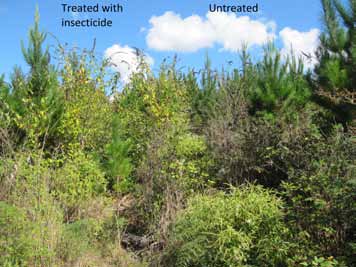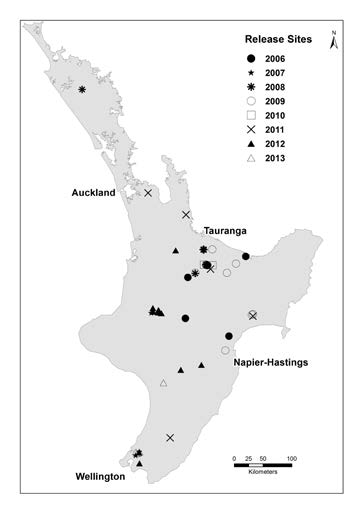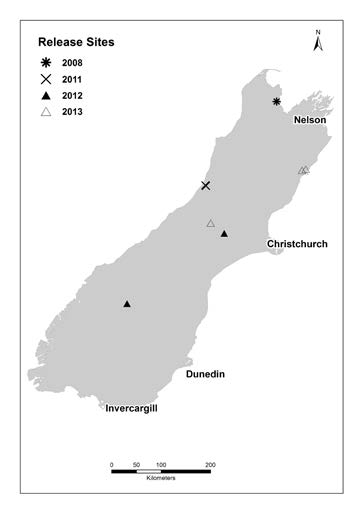PESTS AND DISEASES OF FORESTRY IN NEW ZEALAND
Buddleia biological control update
Scion is the leading provider of forest-related knowledge in New Zealand
Formerly known as the Forest Research Institute, Scion has been a leader in research relating to forest health for over 50 years. The Rotorua-based Crown Research Institute continues to provide science that will protect all forests from damage caused by insect pests, pathogens and weeds. The information presented below arises from these research activities.
From Forest Health News 236, May 2013.
As reported earlier in Forest Health News the buddleia leaf weevil, Cleopus japonicus, was first released in New Zealand by Scion in September 2006 to control the weed buddleia (Buddleja davidii). More than 60 releases of the weevil have now been made (see maps) and it has spread far and wide from these sites.
Sites where the weevil is abundant can be used by interested parties as a source of weevils for release into new areas. November/December or March/ April are excellent times of year to collect adults. To do this, simply beat infested buddleia including its flower heads over an up-turned umbrella or a sheet on the ground below the plant and collect the adults that fall. Provide them with fresh foliage and keep them cool while transporting them to a new site. It is recommended that at least 50 adults are released in an area to maximise the chance of establishment. Larvae can also be moved from one area to another on foliage, but care must be taken to ensure they are able to easily transfer to the new plants as they cannot move far (put the branches in the middle of new plants). They are also easily damaged and killed by temperature extremes.
 This year a four- year field trial in Kaingaroa forest where C. japonicus was released at the edge of a newly harvested stand was completed. The weevil’s feeding damage and impact on the buddleia growth, and the subsequent impact on the growth of the Pinus radiata trees, was closely monitored. Within each of the trial plots half of the buddleia was sprayed with an insecticide to exclude C. japonicus and the remainder left untreated to enable the impact of C. japonicus on buddleia to be quantified. Some untreated plants were completely defoliated and preliminary analysis shows a significant reduction in weed height, but generally this has not been reflected in gains in P. radiata growth.
This year a four- year field trial in Kaingaroa forest where C. japonicus was released at the edge of a newly harvested stand was completed. The weevil’s feeding damage and impact on the buddleia growth, and the subsequent impact on the growth of the Pinus radiata trees, was closely monitored. Within each of the trial plots half of the buddleia was sprayed with an insecticide to exclude C. japonicus and the remainder left untreated to enable the impact of C. japonicus on buddleia to be quantified. Some untreated plants were completely defoliated and preliminary analysis shows a significant reduction in weed height, but generally this has not been reflected in gains in P. radiata growth.
As yet forestry companies in the central North Island, where the weevil has now been abundant for 3-4 years, have not been able to reduce pre- and post-planting herbicide treatments, primarily because other weeds present in the stands still need to be controlled. However if the leaf weevil feeding continues to reduce the vigour and competitive edge of buddleia, then FSC approved herbicides may be suitable for post-planting spraying of the remaining weeds. Some companies have reported that they have been able to reduce roadside sprays where buddleia used to be the main roadside nuisance weed. Heavy defoliation of buddleia within stands has increased the speed and efficiency of thinning and pruning operations.
Scion also completed a series of field surveys of early rotation forests in the central north island managed by Timberlands and Hancock Forest Management to determine the level of C. japonicus damage to buddleia. Cleopus japonicus was found in all stands, but not on all plants surveyed and damage ranged from 0 to 100%.
Although the buddleia biological control project is coming to an end, Scion will continue to encourage the further spread of the weevil to areas in New Zealand with undamaged buddleia. Scion is viewing this biological control programme as a great success, despite our best efforts failing to unequivocally quantify economic savings to forest companies. However, biological control requires a long term view and another decade may see buddleia decreasing in importance as a serious weed in forests.
Michelle Watson


This information is intended for general interest only. It is not intended to be a substitute for specific specialist advice on any matter and should not be relied on for that purpose. Scion will not be liable for any direct, indirect, incidental, special, consequential or exemplary damages, loss of profits, or any other intangible losses that result from using the information provided on this site.
(Scion is the trading name of the New Zealand Forest Research Institute Limited.)



